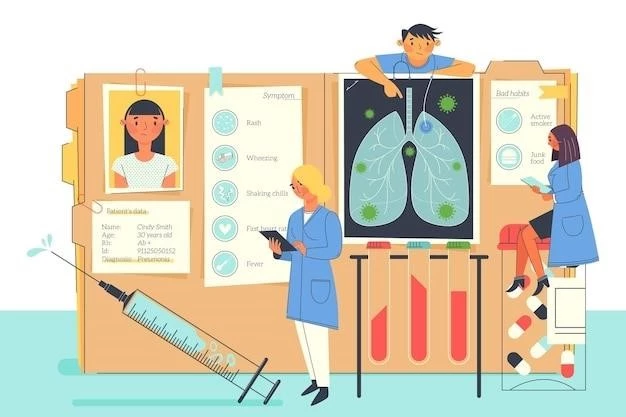Understanding Bronchiectasis
Causes of Bronchiectasis
Symptoms of Bronchiectasis
Diagnosis and Treatment of Bronchiectasis
Lifestyle Changes for Bronchiectasis Management
Complications Associated with Bronchiectasis
Bronchiectasis in Children
Exacerbations of Bronchiectasis
Research and Developments in Bronchiectasis Treatment
Causes of Bronchiectasis
Bronchiectasis can be caused by various factors including⁚
- Respiratory Infections⁚ Chronic infections like pneumonia can damage the airways.
- Autoimmune Conditions⁚ Diseases like rheumatoid arthritis can lead to bronchiectasis.
- Genetic Factors⁚ Conditions like cystic fibrosis can be a cause.
- Inhalation of Foreign Objects⁚ Aspiration of a foreign object can trigger bronchiectasis.
- Immunodeficiency⁚ Weak immune systems can make individuals more susceptible.
- Structural Lung Conditions⁚ Lung conditions present from birth can contribute.
Understanding these causes can help in prevention and management strategies for bronchiectasis.
Symptoms of Bronchiectasis
Bronchiectasis can present with various symptoms, which may include⁚
- Chronic Cough⁚ Persistent coughing can be a common symptom.
- Excessive Mucus Production⁚ Thick, copious sputum can be coughed up.
- Shortness of Breath⁚ Difficulty breathing may occur, especially with physical activity.
- Chest Pain⁚ Discomfort or tightness in the chest may be experienced.
- Recurrent Infections⁚ Frequent respiratory infections are common.
- Fatigue⁚ Feeling tired and lacking energy is a possible symptom.
- Wheezing⁚ Whistling sounds during breathing can be present.
Recognizing these symptoms early is crucial for timely diagnosis and appropriate management to improve quality of life.
Diagnosis and Treatment of Bronchiectasis
Diagnosis⁚ Diagnosis typically involves a combination of tests including⁚
- Imaging Studies⁚ Chest X-rays, CT scans to visualize the airways.
- Sputum Cultures⁚ To identify any bacteria causing infections.
- Pulmonary Function Tests⁚ Assess lung function and capacity.
- Bronchoscopy⁚ Allows direct visualization of the airways.
Treatment⁚ Management often includes⁚
- Airway Clearance Techniques⁚ Physiotherapy to clear mucus.
- Medications⁚ Antibiotics for infections, bronchodilators.
- Pulmonary Rehabilitation⁚ Exercise programs to improve lung function.
- Surgery⁚ In severe cases, surgery to remove damaged lung tissue.
Early diagnosis and a comprehensive treatment plan can help manage symptoms and improve outcomes for individuals with bronchiectasis.
Lifestyle Changes for Bronchiectasis Management
Adopting specific lifestyle changes is crucial in managing bronchiectasis effectively⁚
- Quit Smoking⁚ Smoking can worsen symptoms and damage the lungs.
- Stay Hydrated⁚ Drink plenty of fluids to help reduce mucus thickness.
- Eat a Balanced Diet⁚ Ensure a nutritious diet to support overall health.
- Avoid Lung Irritants⁚ Minimize exposure to smoke, pollution, and strong odors.
- Regular Exercise⁚ Stay active to improve lung function and overall fitness.
- Manage Stress⁚ Stress can exacerbate symptoms, so practice relaxation techniques.
- Follow Treatment Plan⁚ Adhere to medications and therapies as prescribed.
These lifestyle modifications can complement medical treatment and enhance the management of bronchiectasis for a better quality of life.
Complications Associated with Bronchiectasis
Bronchiectasis can lead to various complications that may include⁚
- Respiratory Infections⁚ Frequent infections can further damage the airways.
- Chronic Fatigue⁚ Persistent tiredness due to the body working harder to breathe.
- Pneumonia⁚ Increased susceptibility to lung infections like pneumonia.
- Hemoptysis⁚ Coughing up blood due to damaged airway blood vessels.
- Atelectasis⁚ Lung collapse in a small portion of the lung.
- Cor Pulmonale⁚ Right-sided heart failure due to long-term lung damage.
- Osteoporosis⁚ Weakening of bones due to inflammation and medication side effects.
Regular monitoring and appropriate management can help prevent or minimize these complications, enhancing the quality of life for individuals with bronchiectasis.
Bronchiectasis in Children
Bronchiectasis in children requires special attention and care. Some key points to consider include⁚
- Cause Awareness⁚ Understanding the underlying cause is crucial for effective treatment.
- Symptom Recognition⁚ Recognizing symptoms like cough, recurrent infections, and wheezing.
- Early Diagnosis⁚ Prompt diagnosis can prevent complications and improve outcomes.
- Treatment Tailored for Children⁚ Medications and therapies must be child-appropriate.
- Routine Monitoring⁚ Regular follow-ups to assess lung function and adjust treatment if needed.
- Parent Education⁚ Educating parents on managing symptoms and the importance of treatment adherence.
- Promote Healthy Lifestyle⁚ Encourage a balanced diet, physical activity, and good hygiene practices.
By addressing bronchiectasis in children comprehensively, healthcare providers can help ensure optimal growth, development, and quality of life for young patients.

Exacerbations of Bronchiectasis
Exacerbations, or flare-ups, of bronchiectasis can be challenging. Here are some key aspects to consider⁚
- Early Recognition⁚ Promptly identifying worsening symptoms like increased cough or fever.
- Treatment Adjustment⁚ Working with healthcare providers to adjust medications as needed.
- Airway Clearance Techniques⁚ Consistent use of techniques to clear mucus build-up.
- Infection Management⁚ Addressing infections promptly with appropriate antibiotics.
- Hydration⁚ Ensuring sufficient hydration to help thin out mucus secretions.
- Rest and Recovery⁚ Allowing the body time to heal and regain strength.
- Follow-Up Care⁚ Regular follow-ups post-exacerbation to monitor progress and prevent relapses.
By actively managing exacerbations, individuals with bronchiectasis can better cope with fluctuating symptoms and minimize the impact on their daily lives.
Research and Developments in Bronchiectasis Treatment
Ongoing research offers hope for enhanced treatment options for bronchiectasis. Here are some key areas of development⁚
- New Medications⁚ Exploration of novel drugs targeting inflammation and infection.
- Precision Medicine⁚ Tailoring treatment based on individual genetic factors and disease characteristics.
- Lung Regeneration⁚ Investigating therapies to promote lung tissue repair and regeneration.
- Telemedicine⁚ Utilizing remote monitoring and virtual consultations for improved care access.
- Immunotherapy⁚ Studying ways to modulate the immune system’s response in bronchiectasis.
- Mucus Clearance Devices⁚ Development of innovative devices for more effective airway clearance.
- Bioinformatics⁚ Applying data analytics to understand disease progression and treatment outcomes.
Staying informed about the latest research developments can empower both patients and healthcare providers in making well-informed decisions regarding bronchiectasis management.
